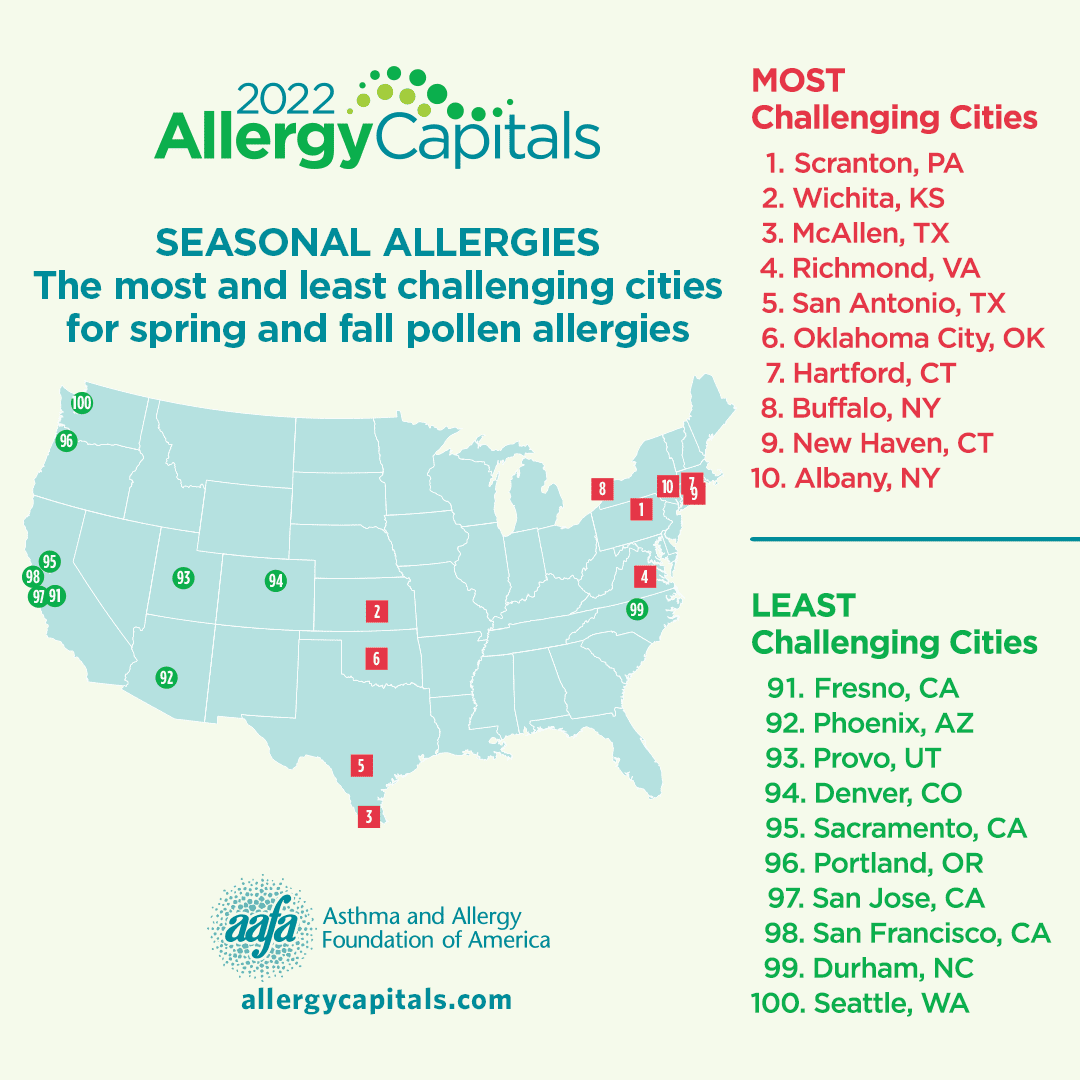Spring is almost here and that means two things: pollen and the release of the Asthma and Allergy Foundation of America’s (AAFA) 2022 Allergy Capitals™ report.
AAFA’s report ranks the top 100 most challenging cities in the continental United States to live with seasonal pollen allergies. The report includes both spring and fall data to create a ranking of the top 100 cities based on:
- Spring and fall pollen scores
- Over-the-counter medicine use
- Availability of board-certified allergists/immunologists
The report also includes seasonal rankings of the top cities for both spring and fall pollen allergies.
The top 10 most challenging cities overall to live in with seasonal allergies in 2022 are:
- Scranton, Pennsylvania
- Wichita, Kansas
- McAllen, Texas
- Richmond, Virginia
- San Antonio, Texas
- Oklahoma City, Oklahoma
- Hartford, Connecticut
- Buffalo, New York
- New Haven, Connecticut
- Albany, New York
People with asthma and allergies should be able to find relief no matter where they live. We release this report each year to help you manage your seasonal allergies. With proper diagnosis, the right treatment, and by reducing contact with pollen, you can feel better and improve your quality of life.
“Schedule an appointment with your allergist to work on a treatment plan together after reviewing your symptoms and considering allergy testing,” says Dr. John James, medical specialist and spokesperson for AAFA. “These measures will help identify specific therapies to help reduce allergy symptoms and to improve your quality of life. There are many options available, including environmental controls and medical treatments, to treat pollen allergies.”
Symptoms of Seasonal Allergies
Seasonal allergies are known as seasonal allergic rhinitis. This is commonly called “hay fever.” Seasonal allergies can cause symptoms during the times of year when pollen counts are high. This is usually in the early spring, during the late summer, and early fall.
The symptoms of seasonal allergic rhinitis are:
- Sneezing
- Stuffy nose (nasal congestion)
- Runny nose (usually a thin, clear discharge)
- Red and watery eyes
- Itchy nose, eyes, ears, or mouth
- Swelling around the eyes
Get Relief From Seasonal Allergies
If you think you have seasonal allergies, a board-certified allergist can help you come up with a plan to manage your seasonal allergies.
Allergy treatment options include:
- Over-the-counter or prescription allergy medicines – such as antihistamines, decongestants, and leukotriene modifiers (such as SINGULAIR®)
- Nasal treatments – such as corticosteroid sprays
- Immunotherapy – allergy shots or tablets for long-term treatment to reduce how severe your allergic reactions are
We also include tips on how you can reduce your contact with pollen to help you manage your symptoms in the 2022 Allergy CapitalsTM report.
Read the report and talk with your doctor about which allergy treatments are right for you.
 SPRING ALLERGY TIP: Keep your windows closed and remove your shoes before entering your home to cut down how much pollen gets inside your home. More pollen allergy tips available at allergycapitals.com from @aafanational
SPRING ALLERGY TIP: Keep your windows closed and remove your shoes before entering your home to cut down how much pollen gets inside your home. More pollen allergy tips available at allergycapitals.com from @aafanational
How Can I Learn More About the Report?
The Allergy Capitals™ ranking is an annual research and education project from AAFA. We release the report to help people recognize, prevent, and safely treat allergy symptoms. Through this ranking, AAFA raises awareness about the impact of spring and fall seasonal allergies. It provides helpful information that can improve the quality of life for people living with seasonal allergies.
Visit allergycapitals.com to see the full list and to learn more about allergy diagnosis, prevention, and treatment.
Join our online community where you can get support for asthma and allergies and stay up to date on news and research.


Comments (1)